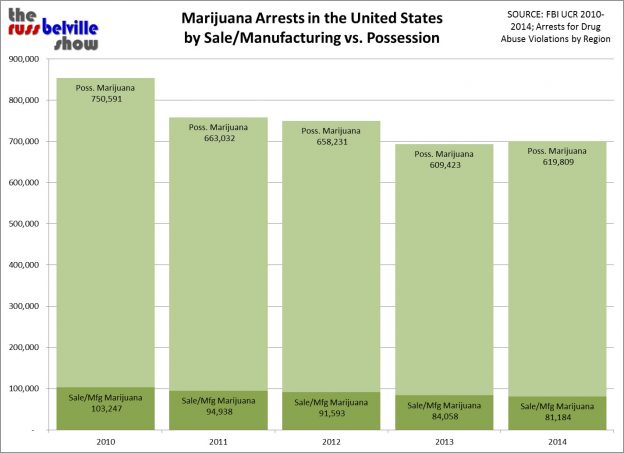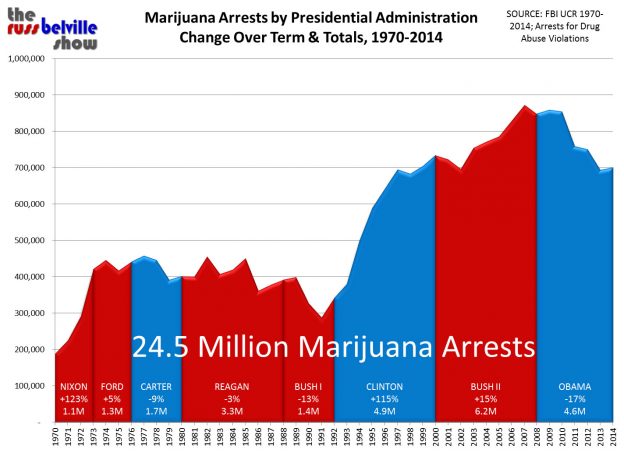Marijuana Legalization Shifts Drug War to Harder Drugs
The FBI’s Uniform Crime Report for 2014 is out and despite the legalization of marijuana in four states, more people were arrested for possession of marijuana and possession of hard drugs this year.
There was an increase in arrests for marijuana law violations for the first time since 2009, breaking the only four-year decrease streak in the history of the War on Drugs. Last year’s marijuana arrest total of 693,482 increased by 7,511 to 700,993, marking a marijuana arrest every 45 seconds in the United States.

The increase in marijuana arrests owes to an increase of 10,385 possession cases nationwide. Marijuana sales and manufacturing arrests actually decreased by 2,874, the only decrease in any drug category for sales and manufacturing or possession. There were 60,188 more drug arrests overall this year, with possession arrests for other dangerous non-narcotic drugs increasing by 24,949, followed by heroin and cocaine possession at 19,238, and possession of synthetic drugs up 5,891. Sales and manufacturing arrests for all other drugs but marijuana combined only increased 2,599.
To put it in perspective, possession arrests for marijuana increased just 1.7 percent, while possession arrests for heroin and cocaine increased 7.8 percent, possession arrests for other dangerous non-narcotics increased 8.0 percent, and possession arrests for synthetic drugs increased 8.5 percent. While arrests for marijuana sale and manufacture dropped 3.4 percent, for all other drugs arrests rose a trifling 1.4 percent.
If Colorado and Washington have made demonstrably fewer marijuana arrests in 2014, the first full year of legal possession and sales in those states, it stands to reason that other states have increased their marijuana possession arrests. Are the police in the states bordering the legal states increasing their arrests, as anecdotes have suggested. Are police nationwide in non-legal states getting in their last possession arrests while they can before legalization comes to their states?
It’s impossible to pinpoint exactly where the increase in marijuana arrests comes from. Table 30 of the FBI UCR breaks down drug abuse violations by region, but its total (1,223,505) doesn’t seem to account for the nationwide total supplied by Table 29 (1,561,231). Furthermore, year-to-year comparisons of state-level data are difficult because of variance in reporting agencies and offense categorization.
However, the FBI Drug Abuse Violations table does break down the percentages of arrests by drug type and shows just how much Western marijuana law reforms have shifted priorities.

Since 2010, the proportion of all drug arrests that were for the possession of marijuana remained slightly stable in the South and Midwest; half or more of all drug arrests there were for marijuana possession. Priorities have shifted slightly in the Northeast, with marijuana possession arrests dropping from 48.3 percent to 44 percent of all arrests, perhaps owing to decriminalization passing in some New England states and a decrease in stop-and-frisk policing in New York City.
But the decrease in marijuana possession focus in the Western states is phenomenal. In 2010, the West already had the lowest focus on marijuana possession nationwide at just 33.5 percent. But following the legalization proposal Proposition 19 in California, which forced then-Governor Schwarzenegger to decriminalize possession, arrests in 2011 dropped to just 23.5 percent. Now, after Colorado and Washington have outright legalized possession of marijuana, those arrests make up only 17.1 percent of all Western drug arrests, about half the proportion they were in 2010.

Even with the slight increase in marijuana arrests for 2014, President Obama’s terms in office mark the greatest decrease in marijuana arrests, 17 percent, since President Nixon declared War on Drugs in 1970. About 4.6 million arrests have occurred while Obama has been in the White House, bringing the overall marijuana arrests total in the War on Drugs to a staggering 24.5 million.






